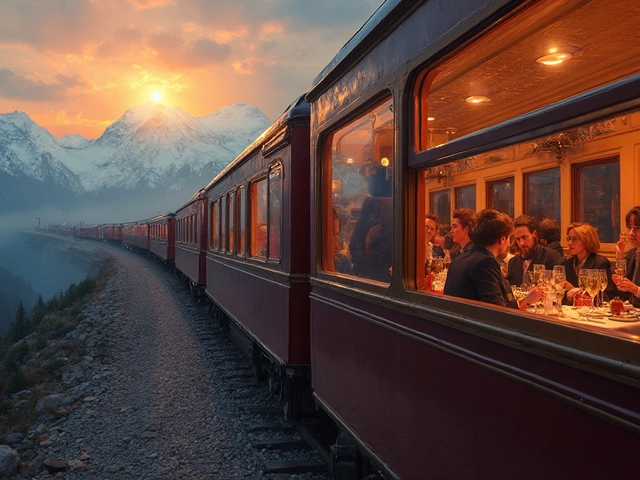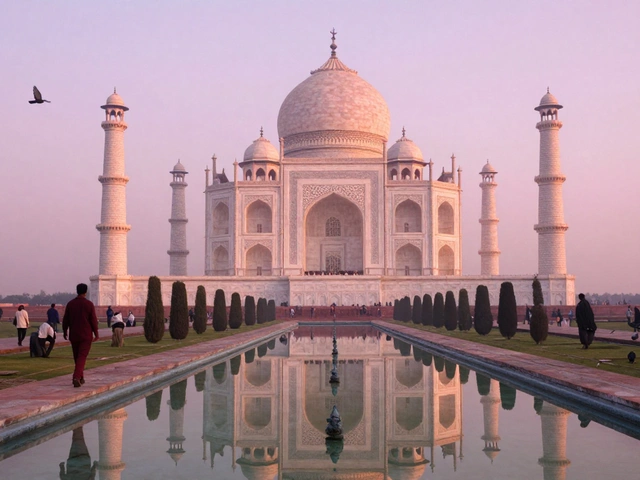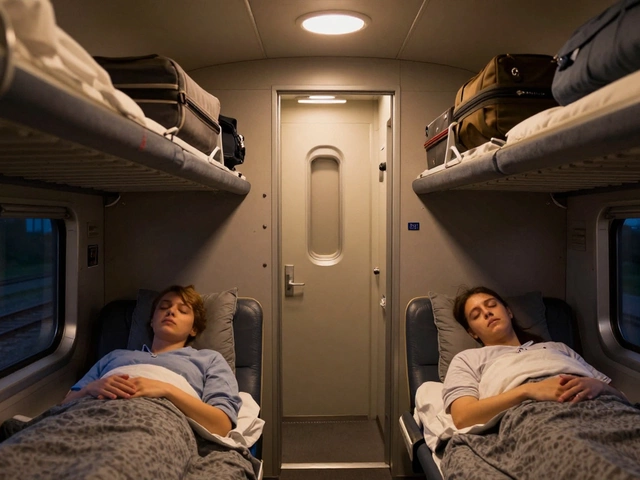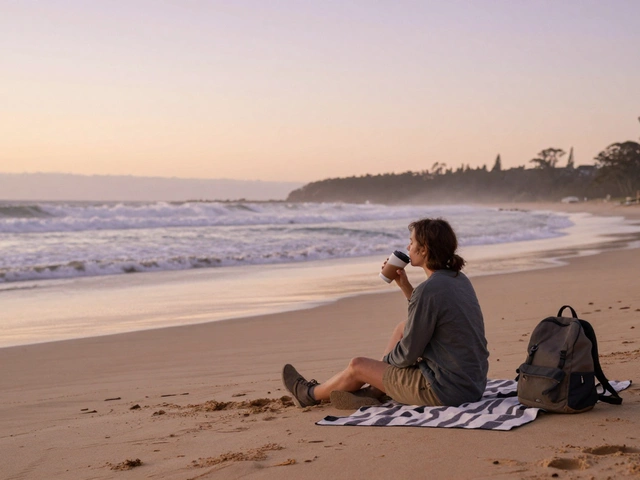No one forgets the first time they hear about the Blue Train. Maybe it’s the name, which sounds almost mythical, or maybe it’s the whispers of gold-trimmed suites and moonlit landscapes slipping past your window. The Blue Train has been branded “the window to the soul of Africa,” but does it really deserve its reputation as a luxury train? The world has plenty of so-called ‘luxury’ experiences that barely pass for above-average. I had that skepticism too, until my curiosity got the better of me—and yes, Liora begged me to show her giraffes from a train window. Imagine me torn between booking the Blue Train, or using the budget on Luna’s next very-necessary vet check. But there’s something irresistible about chasing a travel legend.
The Story and Legacy of the Blue Train
I like stories that start with a touch of nostalgia. The Blue Train isn’t new. It’s been rolling through South Africa since 1946 in its recognizable gleaming blue paint, replacing the old Union Limited that first connected Johannesburg and Cape Town in the early 1900s. Royalty, presidents, movie stars—they’ve all lounged on those velvet banquettes. In fact, Nelson Mandela once rode it. Its carriages have seen decade after decade slip past, with guestbooks full of names you’d see in old Vanity Fair issues. The Blue Train’s route has always hinted at indulgence, gliding over dramatic savannas and between Table Mountain and Pretoria’s gardens.
What really stands out is how the Blue Train was never meant for just getting from A to B. Back in its golden years, it was a status symbol. Fresh flowers in every carriage, crystal clinking between sharply-dressed guests, chefs trained in Europe, and bathrooms so sleek they could make a fancy hotel blush. But it’s not just about who’s ridden it. The train’s staff turn hospitality into a kind of magic trick—old-school service where “no” isn’t an option, and a made-to-order soufflé really will show up at your room at midnight if you ask softly enough.
The train takes about 31 hours for the classic Cape Town to Pretoria route (or vice versa), covering roughly 1,600 kilometers (that’s 994 miles, for the rest of us). Stops aren’t just refueling breaks. There’s a whole planned excursion in Kimberley—home to the Big Hole diamond mine. If you have kids like I do, watching their faces light up when they see a real diamond mine beats any YouTube video. There’s plenty of 21st-century technology behind those classic furnishings too: think Wi-Fi hotspots, movie channels, and air conditioning powerful enough to beat the midday African sun.
The Blue Train’s luxury label grows out of this history. It isn’t trying to be a theme park about luxury; it really is something special to step inside. That catch-your-breath moment when you board and realize you’re playing a small part in something that’s been gliding these rails for so long is real. But there’s more to luxury than just tradition, so let’s dig deeper.
What Makes the Blue Train a “Luxury” Train?
This is the big question with any luxury experience: what are you actually getting? For the Blue Train, it starts with the suites. There are two classes: the De Luxe and the Luxury suites. Both give you your own private compartment with a full en suite bathroom and real marble details. The beds are comfier than most five-star hotels, no joke—I’d challenge anyone not to nap instantly, especially after a lazy lunch in the Dining Car. And yes, there are views: rolling vineyards, jagged mountains, and endless wild veld. Even Luna (our dog) would struggle to find something better to do than sit nose-to-glass for hours.
Service on the Blue Train is in a different league. Every carriage has its own butler (for real). The crew seem to appear just as you think of something. If you want afternoon tea in your cabin, it just shows up, three minutes after you decide you’re actually hungry enough for a little more cake. There’s no tipping pressure. The ticket includes all meals, drinks—yes, even top-shelf single malt—and those midnight snacks if you can’t sleep. Some guests have their shoes polished, suit steamed, or pillows fluffed into clouds. The effort feels invisible, which is exactly how luxury should work.
The food, by the way, is outrageously good. Ever tried ostrich fillet served with South African red wine so smooth it disappears before you notice? The chefs design menus around the season and source loads of produce locally—think Karoo lamb, fresh line fish, and desserts that even Liora (who normally just wants chocolate ice cream) raved about. Dinner is formal and isn’t shy about silverware. Bring something nice—you’ll feel glad you did as soon as the first starter appears.
If you catch the right dates, you might even join one of Blue Train’s themed journeys—jazz evenings, wine tastings, or storytelling nights. Sitting in the Lounge Car, sipping local bubbly with soft music drifting through, you can almost forget you’re traveling at all. For families, the train caters surprisingly well. There are flexible menus for kids, and staff who genuinely seem to delight in small train enthusiasts. It’s quiet, polished, and never snobby—if you’re worried it’s too stuffy, don’t be.
Here’s a basic comparison chart of what you get on the Blue Train versus other trains:
| Feature | Blue Train | Typical Quick Train (e.g., Shosholoza Meyl) |
|---|---|---|
| En Suite Bathroom | Yes, all suites | No, shared |
| Private Butler | Yes | No |
| Inclusive Gourmet Meals | Yes, all meals | No, basic meals for purchase |
| Fine Wines and Premium Beverages | Yes, included | No, limited selection for purchase |
| Excursions/Entertainment | Included | None |
| Wi-Fi/Tech Features | Selected suites and lounges | Limited/none |
| Service Style | Bespoke luxury | Basic transportation |
The Blue Train consistently wins awards—like Africa’s Leading Luxury Train at the World Travel Awards. It stacks up alongside places like the Orient Express or the Maharajas’ Express in India. But for anyone who’s traveled on overnight trains before, the step up in comfort is undeniable. This isn’t just a plush seat and better food—it’s a sensory overhaul from start to finish.
Behind the Price Tag: Is It Worth It?
There’s no way around it—the Blue Train doesn’t come cheap. Prices for the classic journey tend to start at around $1,300 per person (it fluctuates, of course), depending on the suite and the time of year. On paper, it looks wild compared to flying between Cape Town and Pretoria. But before you click away, think about what’s included. One night in a five-star hotel, all your gourmet meals, drinks, private butler service, unbeatable views, the excursion in Kimberley, and the once-in-a-lifetime factor… it starts to make more sense. The value isn’t just in the physical stuff—it’s how it feels to be there.
For special trips—think milestone birthdays, anniversaries, or just ticking off a bucket-list adventure—it stands up. And let’s be honest, you don’t do the Blue Train as a daily commute (unless you win the lottery big-time). Travel insurers, by the way, love that the Blue Train has a near-perfect safety record in recent decades. Families get peace of mind, and solo travelers like to point out how social the lounge and bar cars become within an hour or two. I met a couple from Toronto and a honeymooning pair from Sydney—by breakfast, we were swopping safari stories like old friends.
If you’re traveling with kids, here are some quick tips to get the most value:
- Book as early as you can. Family suites go fast.
- Notify the reservation team about allergies and special food needs—the chefs are incredibly accommodating.
- Pack one dressy outfit per person for dinner. Don’t sweat about kids being perfect—staff are welcoming.
- Bring a few favorite books or travel games for downtime. Wi-Fi can be patchy when crossing the Karoo.
- For milestone moments, mention it when booking—they love surprising guests with goodies in-suite.
And if you want to save a little: travel in low season (usually May to August). Fewer crowds, quieter lounge cars, and sometimes lower fares. Don’t overlook shorter routes or themed journeys that pop up a couple of times a year—those can be a great way to get the Blue Train experience without the splurge.
How Does It Compare? The Blue Train vs. Global Luxury Trains
This is something no one tells you: “luxury” has different meanings depending on where you’re rolling. I’ve heard the Blue Train called the “Orient Express of Africa,” but it’s really its own beast. You know those Instagram reels with people dressed in 1920s outfits on the Venice Simplon-Orient-Express? That train leans retro-glam, all wood paneling and caviar. The Maharajas’ Express in India goes huge on gold leaf and royal suites. By comparison, the Blue Train’s vibe is understated: classic, dignified, not showy. More South African pearls, less Gatsby pearls-and-diamonds.
You get a similar level of privacy and pampering on these trains, but the flavor is totally unique. The landscapes are wildly different—on the Blue Train, one minute you’re watching zebras grazing in the veld, the next you’re winding through vineyards that could make a Bordeaux local jealous. The focus on local cuisine and wines is a South African signature. You’ll see, smell, and taste the country through the windows and at the table, not just in brochures or staged dinners.
Stats show that the Blue Train secures repeat guests from nearly every continent. Americans, Brits, Aussies, and plenty of South Africans treating themselves for their own country’s special experience. The biggest difference? The price. While the Blue Train costs less than some European luxury trains (the Orient Express sometimes pushes past $3,000 for a trip), you don’t lose out on pampering or adventure.
What is consistent: the sense of occasion. Whether you’re on the Blue Train or the Rocky Mountaineer in Canada, there’s something about train travel that feels like stepping into a more elegant, more imaginative past. The pace is slower—intentionally—so you gel with fellow travelers, get properly lost in the scenery, and come away with memories that last way longer than any airline peanuts or airport security lines.
Here’s a quick look at how the Blue Train compares with a few of the big names worldwide:
| Train | Main Route(s) | Starting Price (per person) | Signature Feature |
|---|---|---|---|
| Blue Train | Cape Town – Pretoria | $1,300+ | Private butlers, gourmet local cuisine, Diamond Mine excursion |
| Venice Simplon-Orient-Express | London – Venice | $3,200+ | 1920s décor, white-glove service, vintage carriages |
| Maharajas’ Express | Delhi – Mumbai/varied | $2,850+ | Sumptuous interiors, Indian royal cuisine, palace tours |
| Rocky Mountaineer | Vancouver – Banff/varied | $1,700+ | Glass-domed cars for mountain views, gourmet on board |
If you love the idea of slow travel—of making the journey part of the adventure, not just the boring passage to the next place—the Blue Train won’t disappoint. You’ll swap hours of airport waiting for hours of being absolutely spoiled. Don’t be afraid to unplug a little. The magic’s in the moment, not the itinerary.
Is the Blue Train for Everyone?
So, after all this, is the Blue Train really luxury? It is. But it’s not the kind of flash-your-Instagram-lifestyle luxury you might expect. It’s understated, full of small surprises and moments that feel real and special. It might not be for everyone—and honestly, that’s part of the charm. If you’re looking for wild adventure, this isn’t a safari lodge or a backpacker’s journey. The adventure is in letting go, slowing down, and letting the world roll softly past your window while someone else worries about your next cup of tea.
And the train isn’t immune to criticism. Could the Wi-Fi be a little faster in parts? Sure. Not every suite’s air-con is flawless in the absolute midday heat of the Karoo. But these are tiny moments compared to the big picture—the chance to step into a South African dream, if only for 31 hours.
Here are a few things to keep in mind if you’re thinking about booking:
- Don’t expect big parties—the vibe is relaxed and social, but not wild.
- If you have dietary restrictions, flag them early. The kitchen truly goes out of its way, but they do need to be warned.
- Dress is formal at dinner—think cocktail attire or a jacket. Daytime is way more casual, so comfy shoes and breezy clothes for excursions are fine.
- If you get motion sickness, pack a remedy—though the ride is smooth, it’s still hours of gentle movement.
- Photo buffs: pack a power bank. Outlets are plentiful, but vista shots can drain batteries fast.
- Be social. I met fascinating fellow travelers over afternoon rosé and cheese plates—some of my best travel tips have come from random train conversations.
No train ticks every single box for every traveler. It’s entirely possible—though rare—you might not fall in love with train travel. But if you’re game for a journey that combines tradition, hospitality, and seriously beautiful scenery, the Blue Train holds up its side of the “luxury” promise. I’d ride it again in a heartbeat—well, once Luna forgives me for leaving her behind (again).
So yes, the Blue Train really is a luxury train, but it’s also so much more than that. It’s a piece of living South African history, a “rolling five-star hotel” that just happens to come with sweeping views, world-class food, and stories that last longer than the trip itself.





